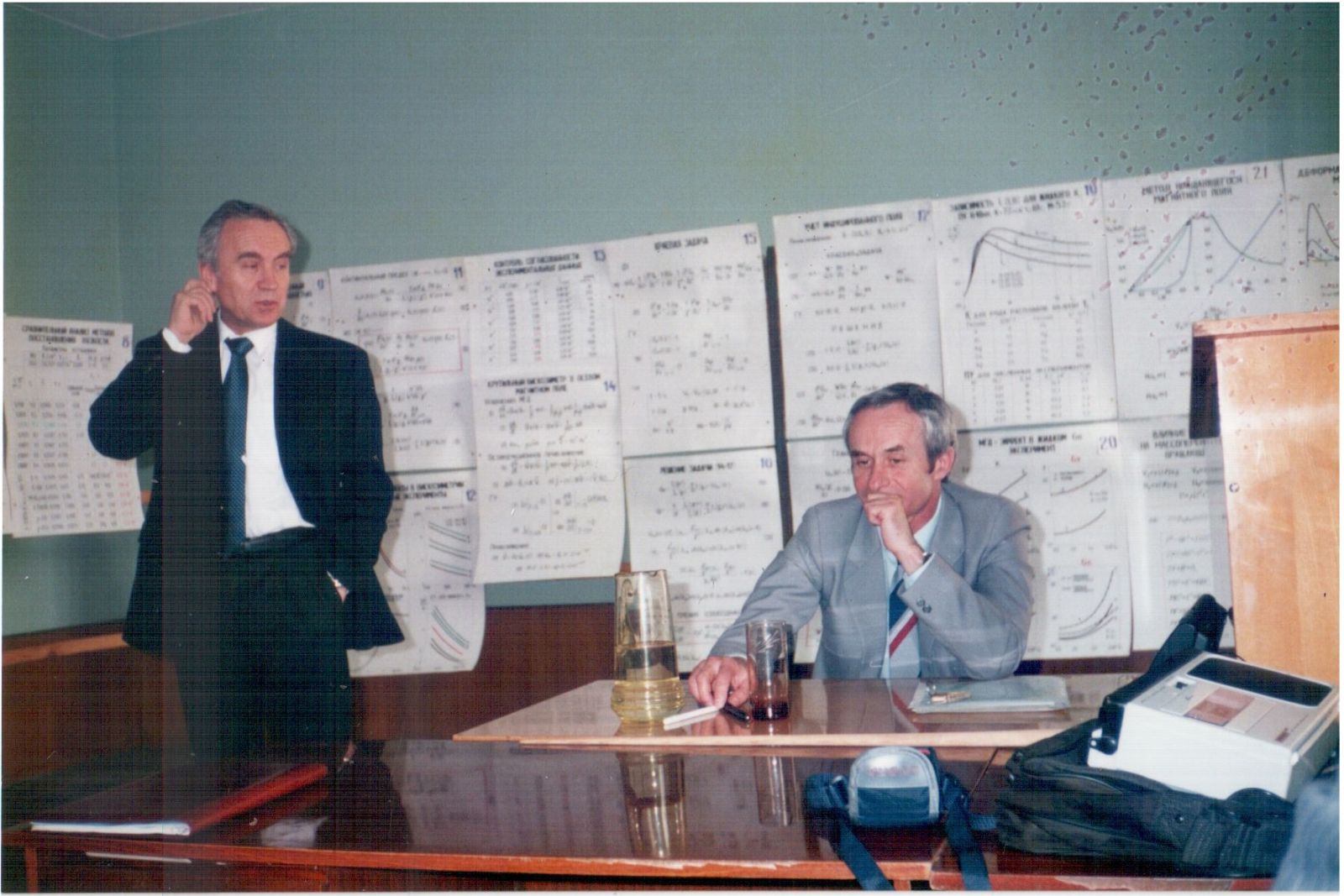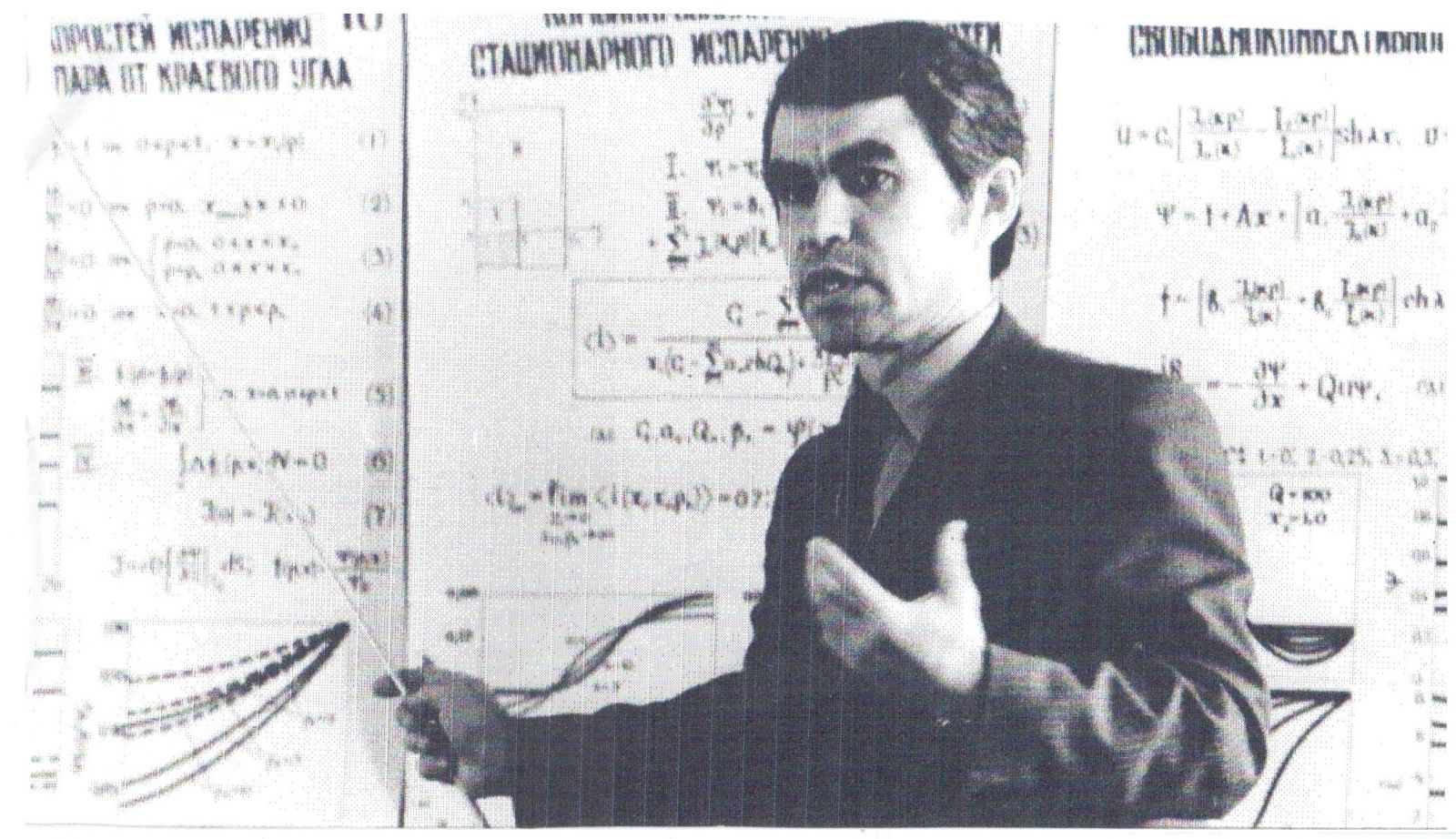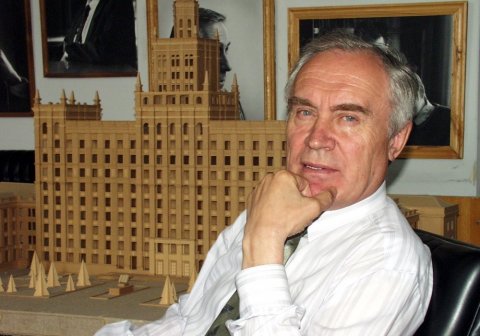Doctor of Sciences (Chemistry), Professor, Corresponding Member of the Russian Academy of Sciences German Vyatkin was the founder of Scientific School of High-temperature Melts Physical Chemistry. Nowadays, studies of this scientific school are conducted on the basis of the Department of Computer Modeling and Nanotechnology of Faculty of Physics of the Institute of Natural Sciences and Mathematics.
German Vyatkin was born on May 1, 1935, in Chelyabinsk, graduated from the Chelyabinsk Polytechnic Institute (today SUSU) in 1958. After graduation, he worked as a blast-furnace keeper in the Blast Furnace Shop of the Chelyabinsk Metallurgical Plant. From 1959 to 1966, he worked at the Chelyabinsk Research Institute of Metallurgy. There his career developed from a laboratory assistant to a senior research assistant. Then he switched to pedagogical work, taking the position of Associate Professor, first at the Department of Metal Technology of the Chelyabinsk Institute of Agricultural Mechanization and Electrification, and since 1967, at the Department of the Steelmaking Industry of the Chelyabinsk Polytechnic Institute. Since 1980, German Vyatkin became Head of Department of Physics No.1; three years later, he became Vice-Rector for Scientific Work, and from January 1985 to August 2005, he acted as Rector of SUSU. From 2005 to the present, a prominent scientist holds the post of President of the University.

In 1963, German Vyatkin defended his Candidate’s dissertation, in 1977, he defended his Doctor’s thesis, and in December 1987, he was elected as a Corresponding Member of the USSR Academy of Sciences and Member of the Presidium of the Ural Branch of Academy of Sciences of the USSR.
German Vyatkin is the author of more than two hundred scientific works, including five monographs. Among his works, there are such as “Surface Segregation and Desorption during Phase Transitions in Metals”, “Determination of the Nature of Hybridization of Valent States of Carbon by Spectroscopic Methods”, “Thermodynamic Modeling in Inorganic Systems”.
In 1993, the scientist was awarded the Order of Friendship of Peoples, in 2000, the Order for Services to the Fatherland of the fourth degree; in 1999, he was awarded the President’s Prize in Education.
The scientific activities of Professor Vyatkin relate to the interests of the metallurgical industry. The first works were carried out in the field of experimental metallurgy and were devoted to the study of the possibilities of using local iron ore raw materials at metallurgical plants of the Southern Urals, as well as improvement of the blast furnace smelting technology, research of the domain processes and ways of their intensification.
In the middle of the 1960s, German Vyatkin carried out a series of studies on the physical and chemical properties of high-magnesian slags, determined their optimal and permissible composition, what made it possible to create an effective technology for processing the iron ores of the Bakal mines. Following this, he solved the problems of obtaining pig iron from the ores of the Lisakovsk mines as well as the issues of the use of coke from the charges with a high content of coals of the Kuznetsk Basin instead of coked Donetsk coals in the blast furnace.
Summarizing the gained experience in the field of experimental metallurgy, the researcher concluded that the further improvement of metallurgical technology is hampered by a lack of knowledge of the physical and chemical nature of metallurgical melts.
In 1974, at the Institute of Metallurgy, a young candidate for the Doctor’s degree, German Vyatkin, together with postgraduates from the Chelyabinsk Polytechnic Institute, Valery Beskachko and Vladimir Monkin, worked in the Laboratory of Phase Composition headed by Nikolai Vatolin, the future Academician of the USSR Academy of Sciences and the Russian Academy of Sciences. Here German Vyatkin for the first time applied integral fluid theories and methods of integral equations and computer modeling to calculate the structure and properties of two-component liquids with Coulomb interaction – ionic melts.
At the same time, intensive experimental studies of ionic melts continued and by the middle of the 1980s concentrated in the Laboratory of Physical Chemistry of Heterogeneous Systems. Together with a student of his, postgraduate Yury Izmailov German Vyatkin investigated in details one of the classes of ionic systems – the ternary mutual oxide-fluoride systems with volatile components. These systems are of considerable interest both from a practical point of view since they are widely used in metallurgy and from a theoretical point of view due to their non-equilibrium in open conditions. The most important regularities of their behaviour were established: the question of the effect on the intensity of mass transfer during the evaporation of the nature of the atmosphere, the material of the vessels, the edge effects on the three-phase boundary, the shape and size of the meniscus of the evaporating liquid. The independence of the rate of evaporation of liquids from the curvature of a concave meniscus forming in a cylindrical vessel was founded.

Many completed developments significantly expand the range of possibilities for physical and chemical studies of mass transfer processes involving systems containing highly volatile toxic compounds. They can be used to optimize the compositions of solutions and melts practiced in chemical and metallurgical industries, as well as to develop environmentally friendly technologies.
Together with postgraduate Anatoly Belonozhko, German Vyatkin performed extensive experiments on the kinetics of evaporation of various kinds of liquids under various conditions, which allowed to determine the impact on the evaporation rate, in particular, geometric factors (capillary radius, height of its free part), three-phase boundaries (liquid - gas - solid body), the shape of the meniscus. Critical analysis of this data forced to reconsider some of the existing views.
In cooperation with Anna Korenchenko, the theoretical models of mass transfer during the evaporation of liquids in a noncondensing gas medium were developed, allowing to calculate the dependences of the evaporation rates on the geometric parameters of the experimental cell and the curvature of the meniscus of the evaporating liquid.
In the late 1980s, in connection with a well-known discussion of the causes of abnormalities in the behaviour of the physical and chemical properties of liquid metals, the scientist, together with Valery Beskachko, began the works on development of the theoretical foundations of experimental techniques: in particular, methods for measuring viscosity, conductivity, and dissolution rates.
Approximately at the same time, interest in the study of the so-called superionic conductors – solid bodies with the property of “sublattice melting” has increased when the atoms of the sublattice of one of the system components acquire almost the same mobility as in liquids but long before the melting of the crystal as a whole. Together with Vladimir Berezin, ceramic high-temperature solid electrolytes were synthesized, which made it possible to investigate the thermodynamics of the “solid superionic – melt” transition.
Together with Tatiana Privalova, German Vyatkin studied the surface properties of materials. The processes of surface segregation and desorption of the components of metal alloys during the course of bulk phase transitions in metal are studied in details in Tatiana Alekseeva’s dissertation work. In Sergey Morozov’s dissertation, a technique for studying the surface of three-component alloys using the technique of temperature-programmed desorption was developed as well as high-temperature surface phases and phase transitions in Fe–Mn–C and Fe–C–S alloys were studied.
After the dissolution of the USSR in 1993, Alexander Mirzoev came to work at the Department of Physics No.1 and the Laboratory of Melt Physics, previously working as a leading researcher in the Department of Physics of Tajik State University in Dushanbe. In Chelyabinsk, he continued to study the electronic and atomic structure of melts, starting with the use of computer modeling means available in the laboratory – molecular dynamics and Monte Carlo method. For several years, Alexander Mirzoev was one of the first in the country to adapt and introduce into research a number of new modern computer methods for calculating the microscopic structure of disordered systems.
Scientific directions, the development of which was started by the first generation of the school in the 1970–80s, gained strength by the 1990s when their results were summarized in the Doctor’s dissertations of Yury Izmailov, Vladimir Berezin, Tatiana Privalova, Valery Beskachko, Alexander Mirzoyev, O.I. Bukhtoyarova, B.S. Vorontsova, L.I. Voronova, Candidate’s dissertations of dozen postgraduates and degree-seeking students. The school gained recognition in Russia and abroad by the works in such areas as experimental studies of metal and oxide melts, methods and techniques of high-temperature experiments, computer modeling of materials of various chemical nature (with metallic, ionic and covalent bonds) being in different thermodynamic conditions (solid , liquid and gaseous state). In the 2000s, the former postgraduates of the 1990s became experienced researchers, formed their points of view on the school development prospects and defended them. In 2007, A.E. Korenchenko became Doctor of Sciences, in 2013 A.G. Vorontsov became Doctor of Sciences, S.I. Morozov and A.N. Sobolev are getting ready for the defence. The graduates of the school of bachelor and master levels can be met in research centres in Russia, Europe, and North America.




